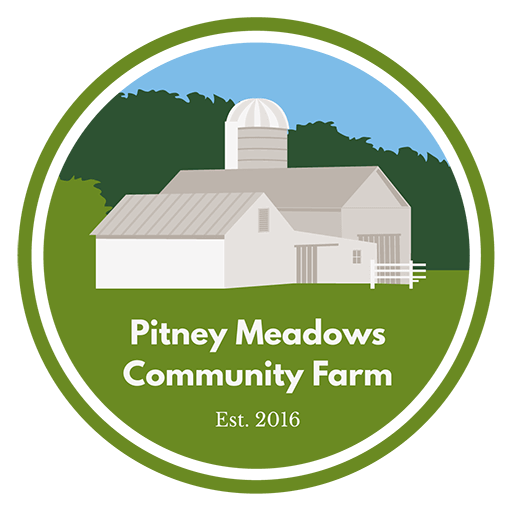Farm Stand Farmer Feature: The Holzworth's & Turtle Rock Farm: Listening to the Land
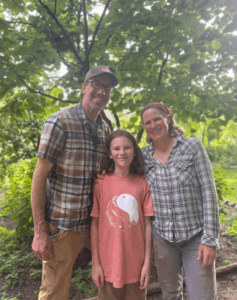 There’s a rock in the middle of the field that won’t move… not by tractor, not by human force. It rises from the soil like the shell of a turtle, immovable and undeniable. “It was one of the first things we were told about the land,” says Kelly. “We decided to leave it. And over time, I’ve learned to love it.”
There’s a rock in the middle of the field that won’t move… not by tractor, not by human force. It rises from the soil like the shell of a turtle, immovable and undeniable. “It was one of the first things we were told about the land,” says Kelly. “We decided to leave it. And over time, I’ve learned to love it.”
The rock gave Turtle Rock Farm its name. But more than that, it gave the Holzworths a kind of orientation… a lesson that would repeat again and again in their years here: you don’t control this land. You listen. You learn. You adapt. You grow with it.
Arlo sees it, too. “It looks like a turtle shell,” he says… not just in name, but in shape, in spirit. One day, he wants to paint it to look like one, to make what’s always been there just a little more visible. It’s a small gesture, but a fitting one; turning something ancient and unmoving into something playful, seen, and fully part of the family story.
Ten years ago, Kelly, Casey, and their young son Arlo became the final family to join a small constellation of growers rooted on preserved farmland, land that nearly became a subdivision of houses. Instead, thanks to the vision and generosity of Barbara Glaser and the support of Saratoga Plan, it remained intact: parceled into five micro-farms and held in conservation for continued growing, learning, and stewardship.
“Barbara’s dream was to keep the land in farming,” Kelly says. “And because of her, we were able to be part of something much bigger.” Each farm has its rhythm, its approach, but they’re all connected by this shared beginning. “We all started from scratch. And from the beginning, the community was incredibly generous, sharing tools, advice, just showing up when we needed each other.”
Together, the Holzworths have turned their parcel into something living, evolving… part garden, part wild, part homestead, part sanctuary.

A Slow Shift Toward Wild
The landscape at Turtle Rock tells its own story. Close to the home, there are beds of beans, a personal passion of Kelly’s, squash, tomatoes, cabbage, and more household favorites of the Holzworths’. Farther out and surrounding, you’ll find asparagus, a stubborn plum tree that can’t be pulled, and perennial fruits like pawpaws, currants, Asian pears, and persimmons. “I’m fruit-curious,” Kelly laughs. “It’s a passion. I want to grow the things I can’t find at the grocery store.”
There’s a shifting sense of scale here: from the practical to the poetic, from the seasonal to the forever. “We used to try to control everything. Keep it neat. But I’ve learned to love the wildness and all the benefits that come with that,” she says. “Now it’s more of a controlled chaos. And the land has taught me how to let go.”
Arlo, now almost eleven, has grown up in step with the place. He helps with the corn… “My favorite crop this year,” builds forts in the trees, and dreams up new projects like the “Hobbit House,” a half-built forest hideaway with a working fireplace and walls still going up. “When it’s finished,” he says, “I’m going to hang out there a lot.”
It’s a childhood shaped by wonder and work, rooted in imagination and responsibility… the kind of freedom that comes from being deeply connected to one place, one family, and one patch of earth that says: you belong here. It is remarkable.
 A Mushroom Grove and a Practice of Patience
A Mushroom Grove and a Practice of Patience
Tucked into a shady grove near a spring-fed pond in the woods just past their homestead, lives the heart of Turtle Rock Farm: the shiitake mushroom grove. It’s here, among the oaks and ferns, that Kelly and Casey return again and again, not just to work, but to remember why they’re doing all of this in the first place.
This is their shared craft, their labor of love, and the clearest example of how farming, for them, became something closer to a spiritual practice. “It’s magic back here,” Kelly says. “In the early morning, with the dew still on the leaves and the light filtering through the trees, it resets my brain. It’s never a hard day out here.”
The process is both ritual and science. Dozens of oak logs are carefully stacked and shocked into fruiting with cold-water soaks in the pond, a mimicry of spring rains that tells the mushrooms it’s time to emerge. Once the fruiting begins, the logs need to be checked daily. Mushrooms appear quickly, sometimes overnight, and if left too long, they’ll be gone to bugs or rot.
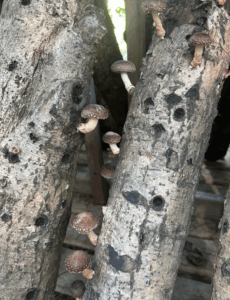 The work is steady, physical, and repetitive. Logs are heavy. Water is cold. Rot is relentless. Slugs creep in constantly, but they’ve learned to outsmart them… laying down siding and upturned buckets, the slugs can’t climb, Casey explains. And still, despite all the effort and ingenuity, the mushrooms remain a kind of miracle. “They’re not cheap. And we eat pounds of them without thinking,” Casey says. “That’s still incredible to me. We’ll throw them on a pizza like it’s nothing — but it is something. It really is.”
The work is steady, physical, and repetitive. Logs are heavy. Water is cold. Rot is relentless. Slugs creep in constantly, but they’ve learned to outsmart them… laying down siding and upturned buckets, the slugs can’t climb, Casey explains. And still, despite all the effort and ingenuity, the mushrooms remain a kind of miracle. “They’re not cheap. And we eat pounds of them without thinking,” Casey says. “That’s still incredible to me. We’ll throw them on a pizza like it’s nothing — but it is something. It really is.”
There’s reverence in how they speak about it… not just pride in growing, but wonder at what the forest gives back. Each log has its own temperament. Each flush arrives in its own time. You can’t rush it. You can only create the conditions and wait.
“In so much of life, especially in farming, you're always chasing something,” Kelly says. “But with mushrooms, there’s this quiet agreement. You do your part, and they do theirs. There’s trust.”
It’s not about maximizing yield or efficiency. It’s about rhythm. Relationship. Patience. Gratitude. And in that grove, among the soaked logs and falling leaves, surrounded by the hush of trees and the sound of water, the Holzworths have found a kind of home inside their home, a place where growing food becomes something sacred.
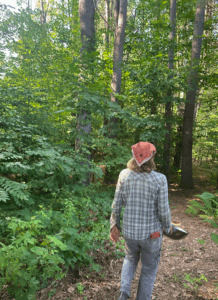 The Hardest Part
The Hardest Part
“The mushrooms are physically hard,” Kelly says, “but what’s actually harder is learning how to listen. Learning when the land is trying to tell you to slow down. That it has its own limits. Just like we do.”
She pauses. “You come in with all these ideas about what you want to grow and do and be. And the land responds. It will show you: this is what I can hold.”
For the Holzworths, that exchange has become a relationship. Not one of extraction, but of care. “The land is part of our family,” Kelly says. “And the plan it has? It’s always bigger than ours.”
So they pay attention. They change course when needed. They let go of perfect rows and instead built places for joy: a swing on the porch, a cat named Popcorn, a pond dug decades ago now full of groundwater and frogs. They end their days with dinner, with laughter, with food they’ve grown together.
“We don’t have a lot of hard days,” Kelly says. “And I’m really grateful for that. Because even on the hard days, this land helps me find my way back.”
A Life, Not a Product: A Celebration of the Slow, the True, the Generous
The Holzworths have built their life intentionally, but not rigidly. They grow food to share, but not at the cost of joy. They farm, but not for scale. “We’re not trying to grow more,” Kelly says. “We’re trying to grow better. Grow what we love. Live how we want to live.”
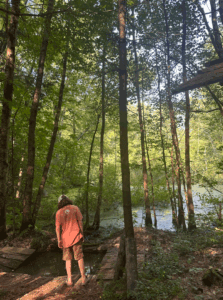 Their goal isn’t to feed thousands, it’s to live honestly and offer what they can with care. Kelly, Arlo, and Casey have been sharing their harvests nearly daily, a practice that embodies community, care, and shared abundance.
Their goal isn’t to feed thousands, it’s to live honestly and offer what they can with care. Kelly, Arlo, and Casey have been sharing their harvests nearly daily, a practice that embodies community, care, and shared abundance.
In a world that rewards speed, growth, and control, Turtle Rock Farm is practicing something quieter, deeper, and more powerful: humility, generosity, and care.
You won’t see endless rows at Turtle Rock Farm, or fields full of tractors. What you will find is nourishment… for soil, for family, for spirit. You’ll find joy in the wildness, calm in the labor, meaning in the mushrooms, and beauty in everything around you.
It’s no surprise that Kelly also helps guide the work of Pitney Meadows as our Assistant Farm Manager… her commitment to land, learning, and community is at the heart of everything she does, both at Turtle Rock and beyond.
And yes… YOU can taste it! Turtle Rock Farm shiitake mushrooms are available in our Pitney Meadows Farm Stand. Come by and take a little piece of their magic home with you… because some food doesn’t just feed you, it teaches you how to live, and these mushrooms do just that!
